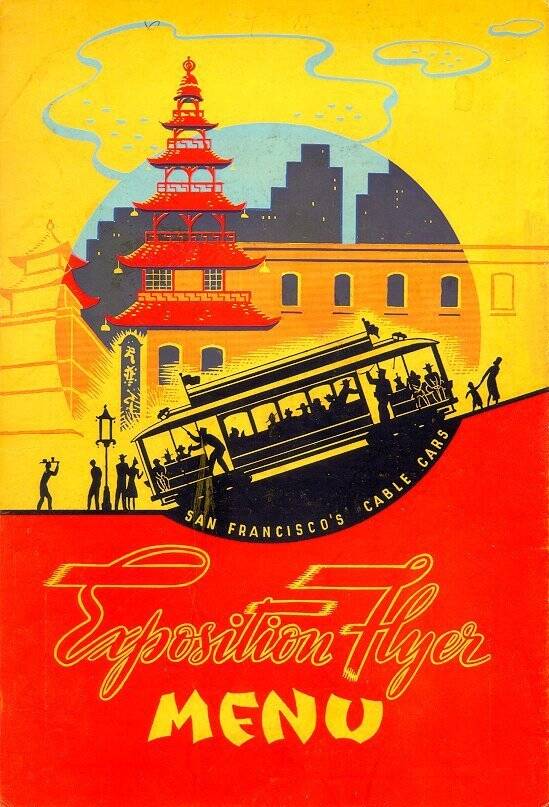
Denver & Rio Grande Western No. 550 leading the Exposition Flyer ca. 1948-1949.
(Unknown photographer, D&RGW Railway, Public Domain via W. Lenheim Collection)
EXPOSITION FLYER
The Exposition Flyer was a passenger train jointly operated by the Chicago, Burlington & Quincy (CB&Q), Denver & Rio Grande Western (D&RGW), and Western Pacific (WP) railroads between Chicago and Oakland, California, for a decade between 1939 and 1949, before being replaced by the famed California Zephyr.
History
In 1939, the Golden Gate International Exposition opened on Treasure Island in San Francisco Bay. In response, the CB&Q, D&RGW and WP decided to operate a train that could take passengers to the event. Service on the Exposition Flyer began on June 10, 1939. In the beginning, the train used steam locomotives as motive power and consisted of the heavyweight Pullman standard cars. In later years, however, the train would operate using diesel power and in the final months of service, used streamlined passenger cars. Initially, the train was supposed to be a temporary route, although, due to the train's popularity, which made it a significant rival to the City of San Francisco, the Chicago-Oakland train operated jointly by the Chicago & Northwestern, Union Pacific and Southern Pacific, it remained in operation until 1949. In 1949, the CB&Q, D&RGW and WP replaced the Exposition Flyer with the all streamlined California Zephyr, which operated over the same route.
Accidents
On the night of September 22, 1941, the eastbound Exposition Flyer collided head-on with a steam locomotive near Sunol, California. The steam locomotive engineer's watch was running slow, and he had failed to move his engine onto a siding. Sadly, three people, including the engineer and fireman on the Exposition Flyer, were killed.
On April 3, 1946, the Exposition Flyer derailed in eastern Nevada after passing over a switch at 45 miles per hour (72 km/h), unfortunately killing two passengers.
On April 25, 1946, the Exposition Flyer was involved in its deadliest accident. The westbound Advance Flyer, another train operated by the CB&Q, made an emergency stop in the Chicago suburb of Naperville, Illinois just short of the CB&Q depot. The Exposition Flyer, traveling at around 85 miles per hour (137 km/h) a short distance behind on the same track, rear-ended the Advance Flyer. Sadly, forty-seven people were killed in the Naperville train disaster, including the Exposition Flyer's fireman.
Route
The Exposition Flyer operated over the CB&Q between Chicago and Denver, the D&RGW between Denver and Salt Lake City, and the WP between Salt Lake City and Oakland. The westbound train left Chicago Union Station at 12:35 pm, and after traversing Illinois, the train crossed the Mississippi River at Burlington, Iowa, continuing through southern Iowa to Denver via Omaha and Lincoln, Nebraska. The train made use of the six 6.5-mile long Moffat Tunnel, and was the first through passenger train to make use of the Dotsero Cutoff, as opposed to the former route via Colorado Springs, Pueblo and the Royal Gorge. After traveling through northern Nevada, the Exposition Flyer traveled through Feather River Canyon, although only those on the westbound Exposition Flyer were able to see the canyon during daylight hours. The train would finally arrive in San Francisco (Oakland with ferry connection to SF) at 10:30 pm two days later. The eastbound Exposition Flyer left San Francisco at 9 pm and arrived in Chicago at 11:55 pm two days later.
Some of the route was shared by the Missouri Pacific Railroad's Scenic Limited, which ran between Kansas City and San Francisco. Beginning in 1946, a through Pullman car to and from New York City was introduced, allowing passengers an uninterrupted coast-to-coast journey via trains operated by the New York Central Railroad and Pennsylvania Railroad on alternating days.
Postcard depiction of the Golden Gate International Exposition on Treasure Island, San Francisco. Click to enlarge.
(Tichnor Brothers, Publisher, Public domain, via Wikimedia Commons)
Golden Gate International Exposition
The Golden Gate International Exposition (GGIE) (1939 and 1940), held at San Francisco's Treasure Island, was a World's Fair celebrating, among other things, the city's two newly built bridges. The San Francisco–Oakland Bay Bridge opened in 1936 and the Golden Gate Bridge in 1937. The exposition opened from February 18, 1939, through October 29, 1939, and from May 25, 1940, through September 29, 1940.
Transportation
The Key System ran special trains to the fair from the East Bay area during the first year, bearing the "X" designation for "Exposition". These trains ran along the same East Bay routes as the Key transbay trains, and used the same rolling stock, the "bridge units", but instead of using the newly opened bridge railway, they were diverted to the old Key System ferry pier ("mole") as there was no stop available at Yerba Buena Island. A ferry crossed the relatively short span of water between the end of the pier and Treasure Island. This service ended at the close of the first phase of the exposition at the end of 1939. In 1940, the "X" train-ferry service was entirely replaced by Key System buses, also designated "X".
The Atchison, Topeka and Santa Fe Railway started a passenger train, the Valley Flyer, to carry passengers between Bakersfield and Oakland during the exposition. The Chicago, Burlington, and Quincy Railroad, Denver and Rio Grande Western Railroad, and the Western Pacific Railroad launched the Exposition Flyer passenger service between Chicago and Oakland, named for the Golden Gate International Exposition.
A menu from the Exposition Flyer. Click to enlarge.
(Western Pacific Railroad, Public domain.)
Overview
Service type: Inter-city rail
Locale: Western United States
First service: June 10, 1939
Last service: 1949
Successor: California Zephyr
Former operator: Chicago, Burlington and Quincy Railroad; Denver and Rio Grande Western Railroad; Western Pacific Railroad
Route Termini: Chicago, Illinois / Oakland, California
Distance traveled: 2,438 miles (3,924 km)
Service frequency: Daily
Train numbers: 39/40








